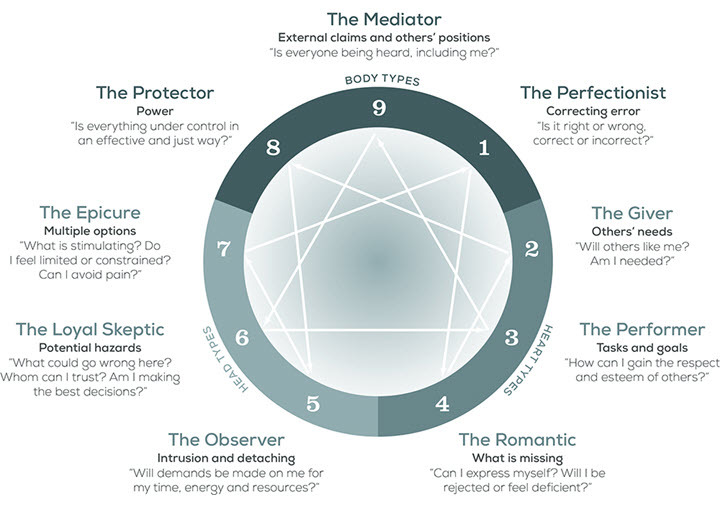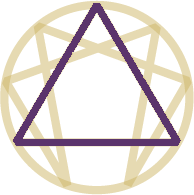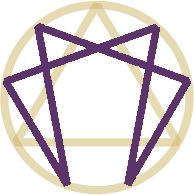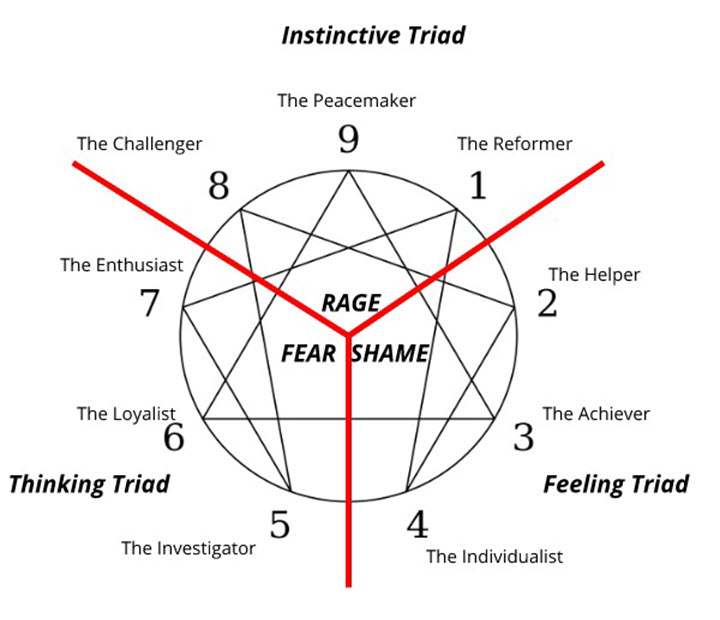36 questions based on the Enneagram of Personality Scales (OSPP) questionnaire
1 question to guess your Enneagram Type based on your Basic Fear
1 question to guess your Enneagram Type based on your Basic Desires
2 questions base on the Quick Enneagram Sorting Test (QUEST) questionnaire
54 questions based on the Stanford Discovery Inventory (SEDIQ) questionnaire
144 questions based on the Riso-Hudson Enneagram Type Indicator (RHETI) questionnaire
180 questions based on the Susan Rhodes Enneagram Type questionnaire

The Enneagram System
The Enneagram is a Personality Typing System comprising nine different types.
The nine types (or "enterotypes," "ennea" means "nine") are universally identified by the numbers 1 to 9.
Therefore, these numbers have a standard way of being placed around the Enneagram symbol.
While it's uncertain whether your type is genetically determined, many believe it is already in place at birth.
People of a particular type have several characteristics in common, but they can be pretty different.
It depends, among other things, on their level of mental health. Unhealthy (neurotic) people from a particular type can look quite different from healthy ones.
It is thought that everyone is considered to be one single type.
However, individuals can have traits belonging to many styles.
Katherine Chernick Fauvre has proposed the Enneagram Tritype®, which consists of one Enneagram Type in each intelligence center.
Although one of these three Enneagram Types is dominant, you use the other two types in your Tritype in a consistent and preferred order.
Although there are many tests to help you try and find your type, the only way to identify with a kind truly is through learning about each class and the triad and for you to select the one that you feel you remember the most.
Fears
A lesser-known fact about the Enneagram is that it isn't meant to be a system that merely identifies clusters of traits.
The Enneagram is a dynamic, growth-oriented inventory that aims to pinpoint one's basic fears and motivations to facilitate personal growth through a specific trajectory.
Which traits you utilize – helpfulness, creativity, dutifulness, etc. – are manifestations of your primary fears. But which behaviors you employ to escape your worries can be situational.
A type six may tap into their creative side to please a mentor – to avoid their primary fear of being without support or guidance – and consequently mistake themselves for a type four.
A type three may act dominant and assertive to progress professionally and mistake themselves for a type eight.
When judging our style based on behavior, we are at high risk of mistyping ourselves.
Just as cognitive functions explain the mental processes that drive each Myers-Briggs type's behavior, the Enneagram's basic fears identify the driving force between the nine types' behaviors.
The best way to identify your type is to learn the basic fears for each class, and then the one that resonates the most with you is most likely your type.
You will see yourself in all the classes, but one will make you feel the most uncomfortable or embarrassed, and this is probably your type.
The Enneagram Symbol
The symbol dates back about 2500 years. However, the actual date of its beginning or where exactly it started is unknown.
It is a coming together of the wisdom of many different spiritual traditions. Much of it has come from Christianity, Buddhism, Islam (especially Sufis), and Judaism.
It encompasses three central figures: the Circle, the Triangle, and the Hexad. Each of these figures is symbolic of the three Laws of the Universe.
The Enneagram symbol illustrates how the "Law of Three" and the "Law of Seven" function in tandem.
The Law of Three implies that every phenomenon results from three opposing forces.
The Law of Seven explains the development of processes. We use the number "7" because it is the law of octaves.
If you're familiar with a musical scale, you'll know that there are seven basic tones (do-re-me-fa-so-la-si), with the fundamental (do) naturally being repeated in playing a musical scale.

The Circle represents the Oneness of life and the container within which we live out the context of our lives.
It represents the Wholeness of humans before we were seemingly fragmented by ego and after we have become aware that we have never lost that Wholeness.

The Triangle represents what is known as the Law of Threes, which states that every whole phenomenon is composed of three separate sources: the Active, the Passive, and the Neutral.
Another is the concept of The Perceiver, the Act of Perceiving, and The Perceived.
The Hexad is a six-pointed figure that follows seven points from the beginning through six changes in momentum, then back to its origin, the seventh point.

The Hexad represents the Law of Seven, which considers the path of movement toward and away from anything in our world as not a straight line, but rather periods along the journey of striving, failing, and striving again, a rising and falling of energies along the path.
The Enneagram Symbol is an overlay of the three elements that symbolizes a path to a fuller, richer life,
To summarize, we see the Enneagram Symbol as a Triangle (Law of Three), a Hexad (Law of Seven), and a Circle (both as laws of unity).
Centers of Intelligence - The Triads
The nine Enneagram Types are further divided into three triads:
- Gut / Body / Instinctive - Emotion: Anger / Rage
- Heart / Feeling - Emotion: Shame
- Head / Thinging - Emotion: Fear
These triads or centers represent perception, processing, and expression modes: moving or sensing (kinesthetically), feeling, and thinking.
Each center's function has its advantages and disadvantages—its positive uses and misuses—ways it helps us interpret and interact with the world around us and can steer us off course.

Again, depending on the type, these emotions are approached differently:
- Externalized
- Internalized
- Repressed
For example...
- Eight's will Externalize their Anger
- Two's will Externalize their Shame
- Five's will Externalize their Fear

The Gut / Body / Instinctive Center
The “body” center includes the “motor” center (Points 8, 9, and 1), which takes an active part in all physical movement, and the “instinctive center,” which corresponds to our instinctual functions.
When thought initiates movements within you, your motor center is activated.
An impulse from the motor, or gut, the center can be a solid guide to the right action, but misuse of the motor center can also lead to impulsive behavior or inertia.
The Heart / Feeling Center
The “heart” center or “emotional” center (Points 2, 3, and 4) regulates the feeling function: the experience and expression of emotions.
It allows you to feel your feelings and connect to others through empathy, but overuse (or misuse) can lead to oversensitivity, insensitivity, or emotional manipulation.
The Head / Thinking Center
The “head” center or “intellectual” center (Points 5, 6, and 7) regulates the thinking function: the experience and expression of thoughts, beliefs, and other cognitive activity.
While essential for dispassionate analysis and reasoning, this form of intelligence can paralyze you if you get caught up in overanalyzing a situation.
Wings
Everyone is a mixture of their primary type, and usually, one of the two adjacent to it on the circumference of the Enneagram.
The types adjacent to your primary type are your Wings.
Your primary type dominates your overall personality. In contrast, the Wings complements it and adds essential, sometimes contradictory, elements to your character.
Your Wings are the “second side” of your personality and must be considered to understand yourself or someone else better.
Some individuals have both Wings, while others are strongly influenced by their primary type and show little of either Wing.
Here are the titles for the nine types with their Wings:
- 1 with Wing 9 - The Idealist
- 1 with Wing 2 - The Advocate
- 2 with Wing 1 - The Servant
- 2 with Wing 3 - The Host/The Hostess
- 3 with Wing 2 - The Charmer
- 3 with Wing 4 - The Professional
- 4 with Wing 3 - The Aristocrat
- 4 with Wing 5 - The Bohemian
- 5 with Wing 4 - The Iconoclast
- 5 with Wing 6 - The Problem Solver
- 6 with Wing 5 - The Defender
- 6 with Wing 7 - The Buddy
- 7 with Wing 6 - The Entertainer
- 7 with Wing 8 - The Realist
- 8 with Wing 7 - The Maverick
- 8 with Wing 9 - The Bear
- 9 with Wing 8 - The Referee
- 9 with Wing 1 - The Dreamer
Subtypes
Subtypes exist within each of the nine types, broken down into three distinct versions according to how the passion (the main type) combines with one of three instinctual biases (drives):
- Self-Preservation
- Social Interaction / Adaptive
- Sexual / Attraction / One-to-One Bonding
When passion and the dominant instinctual drive come together, they create a specific focus of attention, reflecting a particular insatiable need that drives behavior.
These subtypes thus reflect three different "subsets" of the patterns of the nine types that provide even more specificity in describing the individual's personality.
All three instincts operate in all of us. Still, usually only one is dominant in each individual—and when the powerful biological drive of that dominant instinct is put in service of the "passion," it fuels a more specific expression of the personality, resulting in a more nuanced character (a subtype) of the primary personality type.
Self-Preservation
- The Self-Preservation instinct focuses attention on and shapes behavior around issues related to survival and material security.
- It generally directs energy toward safety and security concerns, including having enough resources, avoiding danger, and maintaining a basic sense of structure and well-being.
- Beyond these basic concerns, the self-preservation instinct may emphasize other areas of security in terms of whatever that means for a person of a specific type (once it mixes with one of the nine passions).
- The Self-preservation instinct is related to the Root Chakra.
Social Interaction
- The Social instinct focuses attention on and shapes behavior around belonging, recognition, and relationships in social groups.
- It drives us to “get along with the herd”—our family, the community, and the groups we belong to.
- This instinct also relates to how much power or standing one has relative to the other members of “the group” in terms of whatever that might mean for a person of a specific type.
- The Social instinct is related to the Solar Plexus Chakra.
Sexual / One-to-One Bonding
- The Sexual instinct focuses on and shapes behavior around issues related to the quality and status of relationships with specific individuals.
- It generally directs energy toward the achievement and maintenance of one-to-one connections, interpersonal attraction, and bonding.
- This instinct seeks a sense of well-being through one-to-one connections with people regarding whatever that means for a person of a specific type.
- The Sexual instinct is related to the Sacral Chakra.
Countertypes
There is a “countertype” subtype for each of the nine types.
In every case, with each of the nine points of the Enneagram, two subtypes go with the flow of the energy of the passion, and there is an upside-down one: one that doesn’t look like the others and goes against the main energetic direction of the desire.
This “counter-passional” type is the “countertype” of the three subtypes.
For example, the “counter-phobic” Sexual Six is the most well-known of the countertypes. It’s a Six who’s unafraid.
The passion of the Six is Fear, but the Sexual subtype goes against fear by being strong and intimidating to cope with anxiety.
36 questions based on the Enneagram of Personality Scales (OSPP) questionnaire